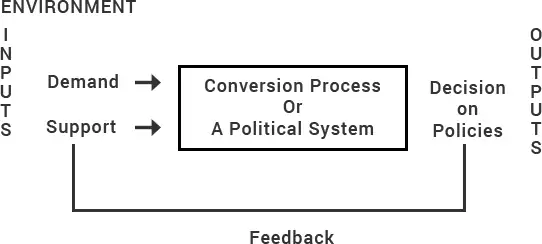Describe David Easton’s Input-Output Analysis in the Policy Making Arena.
David Easton presented the input-output analysis in his article “The Analysis of Political Systems” published in “World Politics” in 1957. It is like a small box consists of two sets of inputs, one output and feedback mechanism to the input side. On the input side, Easton includes demands and supports. Demand is the name of pressure which flow from the environment to the political system to bring about a change in the allocations of score values. And support is the second input. It is the energy in the form of actions or orientation promoting and resisting a political system.
But here the question arises what it does for society. The answer is policy-making. Here comes Easton’s concept of outputs. Outputs are the decisions or policy made by authorities. Further the policies made by the authorities are supported by the people or not. Thus the response or reaction of public to the outputs are feed-back into, the input system. Again the system convert it into output. This cyclic process of input, output and feedback mechanism constitute the Easton’s input-Output analysis, which make decision for the society.

Input-Output Analysis.
The inputs are the pressures of all kinds which are exercised on the system. David Easton was the first political scientist who analyze political system in explicit systems terms distinguishes two types of inputs into the political system, demand and supports. Demand and supports are received by the system from the environment.
Demands.
Demand according to Easton as an expression of opinion that an authoritative allocation with regard to particular subject-matter should or should not be made by those responsible for doing so. The demands may include the demand for wage and working hour, laws, educational opportunities, recreational facilities, roads and transports etc.
There may be demands of behaviour, demand of the right to vote, right to hold office, right to be elected for the office, to petition government bodies and officials and to organize political associations. The demands keep the system operating.
Support.
For survival of the political system, Easton prescribes the concept of support. No political system could last long without the support of the society of which it is a part. This support may be, by accepting the decision of the political system or by obeying them, is the most common way of showing support. Inputs of demands are called as the raw material, out of which finished products called decisions are manufactured.
They are not enough to keep a political system operating. Thus, a political system receives considerable support from the environment. The support is both overt and covert. The overt supports are forms of actions which are clearly and manifestly supportive.
The covert supports are attitudes and sentiments towards the political system. The political system also face support stress by several ways. According to Easton support stress is due to failure of output. The political support decline if the political system fails to deliver the goods.
Conversion Process.
A process through which a political system converts input into output is called the conversion process. It comes through the process of selection, limitation, or rearrangement. The conversion process operates dynamically because the selection can take place over a period of time. This conversion process depends upon the capability of the political system for extraction of resources, regulation and control over individuals and goods.
Outputs.
The outputs of the political system are the decisions of the authorities. It may be rules, regulation, actions, laws and so on. In the first place, authoritative decisions are either application on interpretation of rules. Secondly, the authoritative decisions affect the environment of the political system. Outputs help to maintain support for the political system.
Feedback.
Feedback is a process through which information about the performance of the system is communicated back to it. This information is essential to the authorities who take decision for the system. Through feedback loop the system may take advantage of adjusting its future behavior. Without information feedback, about what is happening in the system, the authorities would have to operate in the dark. It consists of production of outputs by the authorities, a response by the members of the society to these outputs, the communication of information about the response to the authorities and possible succeeding actions by the authorities.
This is a cyclical process. This has been described as a ‘flow model’ of the political system. Easton says that the outputs are not the terminal points. They feedback into the system and which in turn shapes the subsequent behaviour. The feedback thus has a profound influence on the capacity of the system to persist and to cope up with the stress.





